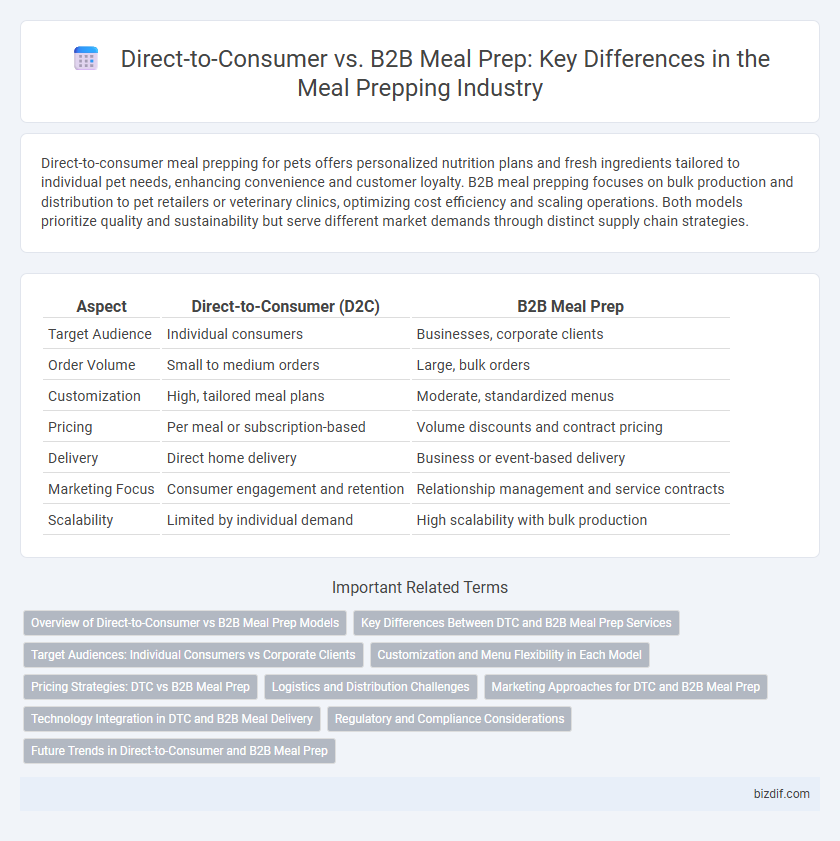Direct-to-consumer meal prepping for pets offers personalized nutrition plans and fresh ingredients tailored to individual pet needs, enhancing convenience and customer loyalty. B2B meal prepping focuses on bulk production and distribution to pet retailers or veterinary clinics, optimizing cost efficiency and scaling operations. Both models prioritize quality and sustainability but serve different market demands through distinct supply chain strategies.
Table of Comparison
| Aspect | Direct-to-Consumer (D2C) | B2B Meal Prep |
|---|---|---|
| Target Audience | Individual consumers | Businesses, corporate clients |
| Order Volume | Small to medium orders | Large, bulk orders |
| Customization | High, tailored meal plans | Moderate, standardized menus |
| Pricing | Per meal or subscription-based | Volume discounts and contract pricing |
| Delivery | Direct home delivery | Business or event-based delivery |
| Marketing Focus | Consumer engagement and retention | Relationship management and service contracts |
| Scalability | Limited by individual demand | High scalability with bulk production |
Overview of Direct-to-Consumer vs B2B Meal Prep Models
Direct-to-consumer meal prep models prioritize personalized meal plans delivered directly to individual customers, leveraging subscription services and digital platforms to enhance convenience and customization. B2B meal prep models focus on bulk meal production for corporate clients, institutions, or healthcare facilities, emphasizing efficiency, consistency, and scalability to meet large-scale demand. Both models utilize advanced logistics and supply chain management but differ significantly in target audience, order volume, and operational complexity.
Key Differences Between DTC and B2B Meal Prep Services
Direct-to-consumer (DTC) meal prep services prioritize personalized convenience, delivering ready-to-eat meals directly to individual customers, focusing on customization, health preferences, and subscription flexibility. Business-to-business (B2B) meal prep services cater to corporate clients, institutions, or food service providers, emphasizing bulk orders, cost-efficiency, and consistent quality control. Key differences include target market size, purchasing volume, customization options, and distribution logistics, which impact pricing models and menu variety.
Target Audiences: Individual Consumers vs Corporate Clients
Direct-to-consumer meal prepping targets individual consumers seeking personalized, convenient, and health-focused meal solutions, often leveraging customizable menus and subscription models to meet diverse dietary preferences. B2B meal prep services cater to corporate clients by providing bulk orders, standardized meal plans, and scalable delivery options designed to enhance employee wellness programs and boost workplace productivity. Understanding the distinct needs of these target audiences enables meal prep businesses to tailor marketing strategies and operational processes effectively, increasing customer satisfaction and retention.
Customization and Menu Flexibility in Each Model
Direct-to-consumer meal prep models offer high customization and menu flexibility, allowing customers to select specific dietary preferences, portion sizes, and ingredient substitutions tailored to individual needs. In contrast, B2B meal prep services prioritize streamlined menus designed to accommodate a broader workforce palate, often limiting customization to balance cost efficiency and volume production. The direct-to-consumer approach emphasizes personalized nutrition plans, while B2B models focus on scalable, consistent meal options for employee programs or institutional catering.
Pricing Strategies: DTC vs B2B Meal Prep
Direct-to-consumer (DTC) meal prep pricing typically emphasizes smaller batch production with premium ingredient sourcing, allowing for higher per-unit prices due to individualized packaging and customized meal options. B2B meal prep often leverages economies of scale, enabling lower per-unit costs through bulk contracts with corporate clients or institutions while maintaining consistent quality and portion sizes. Strategic pricing in DTC focuses on consumer convenience and flexibility, whereas B2B pricing capitalizes on volume discounts and long-term partnerships to optimize profitability.
Logistics and Distribution Challenges
Direct-to-consumer meal prep requires efficient last-mile delivery systems to maintain freshness and manage variable order volumes, often demanding advanced temperature-controlled packaging and real-time tracking technology. In contrast, B2B meal prep focuses on bulk distribution logistics, optimizing route planning for large-scale deliveries to institutional clients like schools or corporate cafeterias, necessitating robust inventory management and compliance with food safety regulations. Both models face challenges in coordinating supply chains, but B2B benefits from predictable demand, while direct-to-consumer must adapt quickly to fluctuating customer preferences.
Marketing Approaches for DTC and B2B Meal Prep
Direct-to-consumer (DTC) meal prep marketing emphasizes personalized digital campaigns, social media engagement, and influencer partnerships to attract individual customers seeking convenience and health optimization. B2B meal prep marketing focuses on relationship building, bulk order incentives, and collaborations with corporate wellness programs to appeal to businesses aiming to enhance employee productivity and satisfaction. Leveraging data analytics and customer feedback in both strategies optimizes targeting and improves service offerings tailored to distinct consumer needs.
Technology Integration in DTC and B2B Meal Delivery
Technology integration in DTC meal prepping leverages personalized apps, AI-driven meal customization, and direct customer feedback systems to enhance user experience and streamline ordering processes. B2B meal delivery incorporates robust inventory management software, automated supply chain solutions, and data analytics to optimize bulk order fulfillment and maintain consistent quality. Both models increasingly adopt IoT-enabled kitchen devices and cloud-based platforms to improve operational efficiency and real-time communication.
Regulatory and Compliance Considerations
Direct-to-consumer meal prep services must comply with food safety regulations tailored to home delivery, including labeling requirements under the FDA's Food Safety Modernization Act (FSMA) and temperature control standards to prevent contamination during transit. B2B meal prep providers face stringent compliance mandates involving Hazard Analysis Critical Control Points (HACCP) protocols and routine inspections by health departments to ensure food safety in institutional settings. Both models require adherence to allergen labeling laws, traceability standards, and employee hygiene protocols to meet federal and state regulatory frameworks.
Future Trends in Direct-to-Consumer and B2B Meal Prep
The future of direct-to-consumer meal prepping is driven by personalized nutrition through AI-powered meal plans and seamless mobile ordering platforms, enhancing customer engagement and convenience. In the B2B sector, emerging trends include scalable meal solutions tailored for corporate wellness programs and sustainable sourcing to meet regulatory compliance and environmental goals. Both markets are rapidly integrating advanced data analytics and automation to optimize supply chains and reduce food waste, reflecting a shift toward efficiency and sustainability.
Direct-to-consumer vs B2B meal prep Infographic

 bizdif.com
bizdif.com